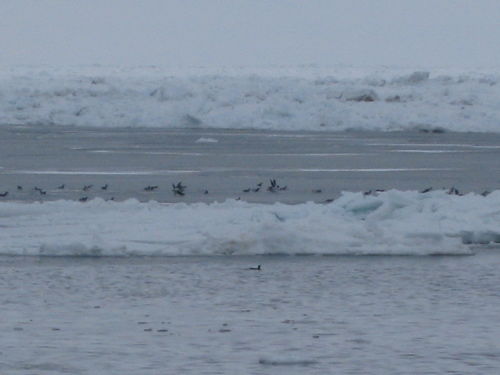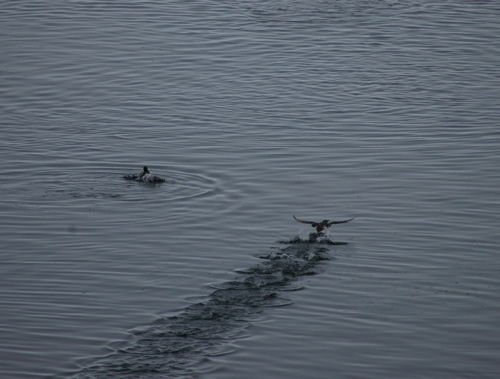Sliding through the ice in transit to our next station yesterday evening, all was serene off the "fantail" (the back porch of the boat). Sitting on a ledge in the back window, I could see grease ice and glassy water in every direction. Over the radio a voice crackled suddenly, "There's birds off the bow. Hundreds of them!" Grabbing my camera and quickly heading to the bow I found that the sea ahead was peppered with movement.
 There were Murres in the water everywhere you looked. The splashes in the front are also birds!The way that they moved in and under the water looked like popcorn beginning to pop. They are quick little guys that are bobbing under and up as fast as they can swallow!
There were Murres in the water everywhere you looked. The splashes in the front are also birds!The way that they moved in and under the water looked like popcorn beginning to pop. They are quick little guys that are bobbing under and up as fast as they can swallow!
Diving through the water, away from the boat, were literally hundreds of little Murres. Thick-billed Murres are pelagic birds that live in the Bering Sea, thriving off of the little fish and Euphausids, (small shrimp) that live around and under the ice. (New word O-A students: pelagic means that they are related to the sea.) Underwater they are extremely acrobatic, swimming breaststroke headfirst with their webbed feet trailing behind. Their colonies, high up on the rocky cliffs, have thousands of birds living in them at once. Evolutionarily smart, Murre's eggs are shaped with one end pointed. This increases their survival rate as a round egg is more likely to roll over a cliff-side than an oblong one. This is especially important as the eggs are laid directly on the rock face without the advantage of a nest to protect them from rolling around. Each egg is beautifully colored like an Easter egg. Having a unique appearance helps adult birds to identify their eggs in a colony of many. Counter-shading, black coloration on top with white underbellies, helps camouflage them both from predators looking up through the water or on the wing from above.
On top of the water they move quickly although a bit comically, diving and skittering all at once. Last night, they looked as if they were skating the top of the water as they fled from the bow of the boat. Some of the birds scrambled onto the ice and then continued to try to "swim" from there. As the boat pulled away, calm was restored and presumably they went back to feeding rather than fleeing from the large red metal animal crashing through the ice.
 This guy was on the wing but couldn't make up his mind. Water or air? Maybe he was too full to fly!
This guy was on the wing but couldn't make up his mind. Water or air? Maybe he was too full to fly!
According to Liz Labunski, wildlife biologist with the US Fish and Wildlife Service, when baby chicks are ready to fledge (fly for the first time) the father chick takes the parenting lead. Like a dad teaching his child to ride a bike, he walks to the edge of the cliff, leaps off and lands feet first on the water. He then waits patiently below for his protégé to follow. Super-dad!

